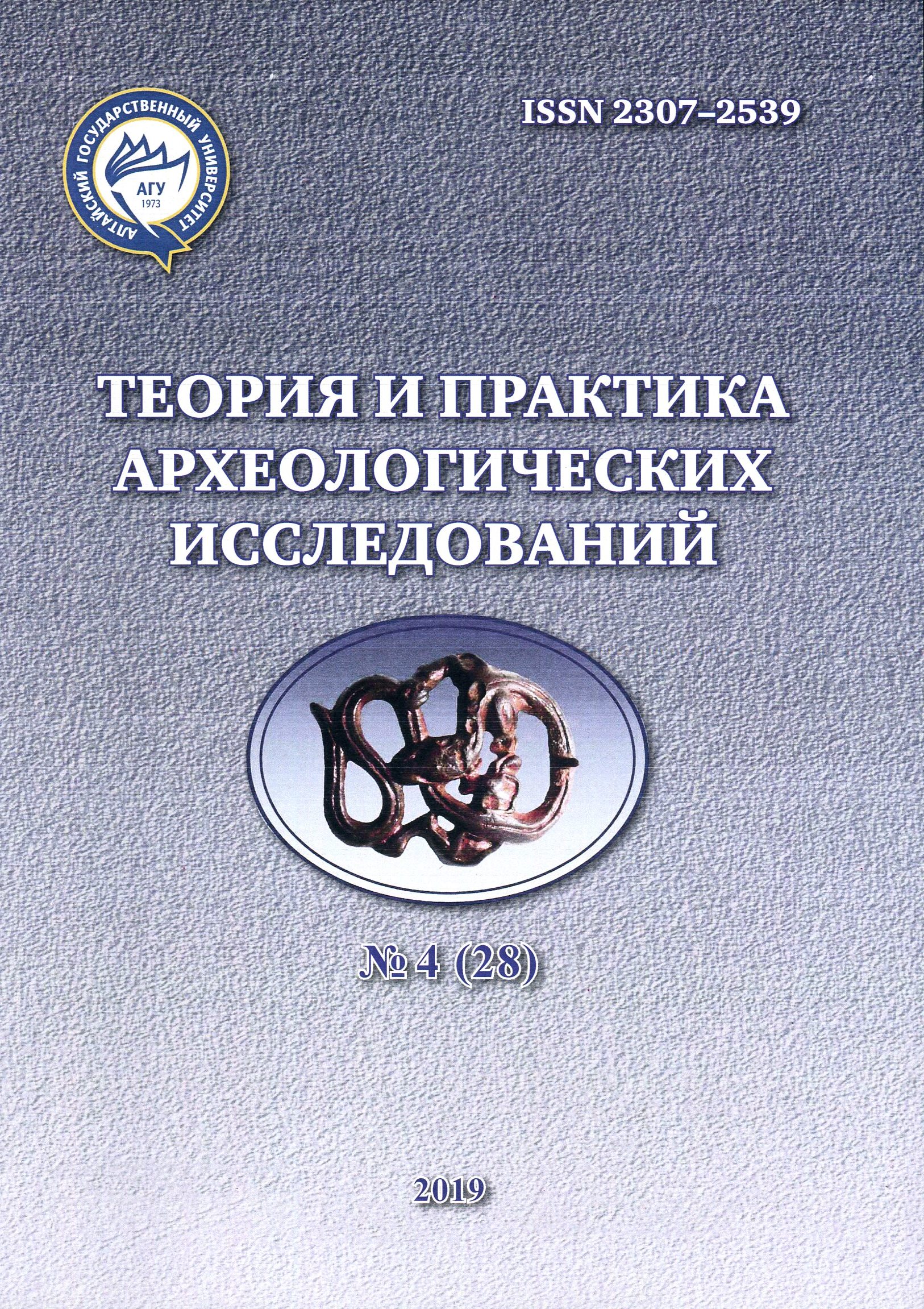NEW DATA ON THE INITIAL UPPER PALEOLITHIC ASSEMBLAGES FROM THE USHBULAK SITE (based on evidence from the southern part of the site)
Abstract
This article presents the results from a study of the southern part of the Paleolithic site of Ushbulak, based on the evidence documented in test pit 5. The site is located in the Shilikty Valley (North-Eastern Kazakhstan) and was discovered in 2016. In 2016–2018, four test pits, a trench and two excavations were produced at the site. Test pit 5 is situated on the bank of a stream, 15 m south of excavation 2, in geomorphological conditions similar to those present in the latter. Archaeological excavations in the test pit were carried out in 2017 and 2018. Fieldresearch has made it possible to reveal a stratigraphic section that includes 5 layers, as well as a collection of archaeological finds (2,802 specimens). A comparative analysis of the sections shows that the lithological units recognized in test pit 5 have their counterparts in the layers from excavation 2. The primary flaking in the stone tool industry from test pit 5 appears to have been focused on producing blades in the context of parallel volumetric counter reduction. The tool assemblage includes end-scrapers, retouched blades, double burins, retouched points, knives, and truncated blades. Based on techno-typological characteristics, stone artifacts from test pit 5 are similar to the Initial Upper Paleolithic assemblages from excavation 2. This is corroborated by the fact that lithics indicative of the Initial Upper Paleolithic stone tool industries from South Siberia and northern Central Asia, such as points with a trimmed base, truncated faceted pieces, notched blades, and core-shaped burin, were found to be present in the archeological assemblage from test pit 5. The presence of evidence in the archeological assemblages and stratigraphy of test pit 5, showing a close analogy to that from excavation 2, confirmed that the southern part of the Ushbulak site has promising prospects for further study
Downloads
Metrics
No metrics found.
References
Anojkin A.A., Tajmagambetov Zh.K., Pavlenok G.D., Shalagina A.V., Bocharova E.N., Markovskij G.I., Gladyshev S.A., Ul’yanov V.A., Chekha A.M., Kozlikin M.B., Iskakov G.T., Vasil’ev S.K., Shun’kov M.V. Issledovanie industrij nachalnogo verhnego paleolita na stoyanke Ushbulak (Vostochnyj Kazahstan) v 2018 godu [The Research into the Industries of the Initial Upper Paleolithic at the Ushbulak Site in 2018]. Problemy arheologii, etnografii, antropologii Sibiri i sopredelnyh territorij [Problems of Archaeology, Ethnography, Anthropology of Siberia and Neighboring Territories]. Novosibirsk : Izd-vo In-ta arheologii i etnografii SO RAN, 2018. Vol. XXIV. Pp. 18–24. DOI: 10.17746/2658-6193.2018.24.018-024.
Anojkin A.A., Tajmagambetov Zh.K., Ul’yanov V.A., Harevich V.M., Shalagina A.V., Pavlenok G.D., Markovskij G.I., Gladyshev S.A., Chekha A.M., Iskakov G.T., Vasil’ev S.K. Issledovanie industrij nachalnyh ehtapov verhnego paleolita na stoyanke Ushbulak-1 (Vostochnyj Kazahstan) v 2017 godu [The Research into the Initial Upper Paleolithic Industry on the Ushbulak-1 Site (Eastern Kazakhstan) in 2017]. Problemy arheologii, etnografii, antropologii Sibiri i sopredelnyh territorij [Problems of Archaeology, Ethnography, Anthropology of Siberia and Neighboring Territories]. Novosibirsk : Izd-vo In-ta arheologii i etnografii SO RAN, 2017. Vol. XXIII. Pp. 19–25.
Derevianko A.P., Shun’kov M.V., Anojkin A.A., Tajmagambetov Zh.K., Ul’ianov V.A., Harevich V.M., Kozlikin M.B., Markovskij G.I., Shalagina A.V., Pavlenok G.D., Gladyshev S.A., Chekha A.M., Iskakov G.T. Arkheologicheskie raboty v Shiliktinskoj doline na vostoke Kazakhstana v 2017 godu [The 2017 Archaeological Study in the Shilikty Valley in the East Kazakhstan Region]. Problemy arheologii, etnografii, antropologii Sibiri i sopredelnyh territorij [Problems of Archaeology, Ethnography, Anthropology of Siberia and Neighboring Territories]. Novosibirsk : Izd-vo In-ta arheologii i etnografii SO RAN, 2017. Vol. XXIII. Pp. 93–98.
Pavlenok G.D., Anojkin A.A., Tajmagambetov Zh.K., Ul’yanov V.A., Markovskij G.I., Gladyshev S.A., Shalagina A.V., Chekha A.M., Iskakov G.T. Issledovanie final’noplejstocenovyh materialov stojanki Ushbulak v 2018 godu [Research into the Final Pleistocene Materials of the Ushbulak Site in 2018]. Problemy arheologii, etnografii, antropologii Sibiri i sopredelnyh territorij [Problems of Archaeology, Ethnography, Anthropology of Siberia and Neighboring Territories]. Novosibirsk : Izd-vo In-ta arheologii i etnografii SO RAN, 2018. Vol. XXIV. Pp. 137–141. DOI: 10.17746/2658-6193.2018.24.137-141.
Pavlenok G.D., Anojkin A.A., Tajmagambetov Zh.K., Ul’yanov V.A., Shalagina A.V., Harevich V.M., Markovskij G.I., Gladyshev S.A., Chekha A.M., Iskakov G.T., Vasil’ev S.K. Issledovanie industrij rubezha plejstocena i golocena na stojanke Ushbulak-1 v 2017 godu [The 2017 Study of the Pleistocene-Holocene Transitional Stone Tool Industries]. Problemy arheologii, etnografii, antropologii Sibiri i sopredelnyh territorij [Problems of Archaeology, Ethnography, Anthropology of Siberia and Neighboring Territories]. Novosibirsk: Izd-vo In-ta arheologii i etnografii SO RAN, 2017. Vol. XXIII. Pp. 182–185.
Petrin V.T., Tajmagambetov Zh.K. Kompleksy paleoliticheskoj stojanki Shul’binka iz Verhnego Priirtysh’ja [Аrchaeological Complexes of Shulbinka Paleolithic Site in the Upper Irtysh Basin]. Almaty : Izd-vo KGNU im. Al-Farabi i In-ta arheologii i etnografii SO RAN, 2000. 165 p.
Tajmagambetov Zh.K., Ozherel’ev D.V. Pozdnepaleoliticheskie pamjatniki Kazahstana [Late Paleolithic Sites of Kazakhstan]. Almaty : Kazak universiteti, 2009. 256 p.
Shun’kov M.V., Tajmagambetov Zh.K., Anojkin A.A., Pavlenok K.K., Harevich V.M., Kozlikin M.B., Pavlenok G.D. Novaya mnogoslojnaya verhnepaleoliticheskaya stoyanka Ushbulak-1 v Vostochnom Kazahstane [New Multistratified Upper Paleolithic Site Ushbulak-1 in Eastern Kazakhstan]. Problemy arheologii, etnografii, antropologii Sibiri i sopredelnyh territorij [Problems of Archaeology, Ethnography, Anthropology of Siberia and Neighboring Territories]. Novosibirsk : Izd-vo In-ta arheologii i etnografii SO RAN, 2016. Vol. XXII. Pp. 208–213.
Derevianko A.P., Gao Xing, Olsen J.W, and Rybin E.P. The Paleolithic of Dzungaria (Xinjiang, Northwest China) Based on Materials from the Luotuoshi Site // Archaeology, Ethnology & Anthropology of Eurasia. 2012. Vol. 40 (4). Pр. 2–18.
Kuhn S.L., Zwyns N. Rethinking the initial Upper Paleolithic // Quaternary International. 2014. Vol. 347. Pр. 29–38. DOI: 10.1016/j.quaint.2014.05.040.
Rybin E.P. Tools, beads, and migrations: Specific cultural traits in the Initial Upper Paleolithic of southern Siberia and Central Asia // Quaternary International. 2014. Vol. 347. P. 39–52. DOI: 10.1016/j.quaint.2014.04.031.
Theory and Practice of Archaeological Research is a golden publisher, as we allow self-archiving, but most importantly we are fully transparent about your rights.
Authors may present and discuss their findings ahead of publication: at biological or scientific conferences, on preprint servers, in public databases, and in blogs, wikis, tweets, and other informal communication channels.
Theory and Practice of Archaeological Research allows authors to deposit manuscripts (currently under review or those for intended submission to ABS) in non-commercial, pre-print servers such as ArXiv.
Authors who publish with this journal agree to the following terms:
- Authors retain copyright and grant the journal right of first publication with the work simultaneously licensed under a Creative Commons Attribution License (CC BY 4.0) that allows others to share the work with an acknowledgement of the work's authorship and initial publication in this journal.
- Authors are able to enter into separate, additional contractual arrangements for the non-exclusive distribution of the journal's published version of the work (e.g., post it to an institutional repository or publish it in a book), with an acknowledgement of its initial publication in this journal.
- Authors are permitted and encouraged to post their work online (e.g., in institutional repositories or on their website) prior to and during the submission process, as it can lead to productive exchanges, as well as earlier and greater citation of published work (See The Effect of Open Access).








2.jpg)




